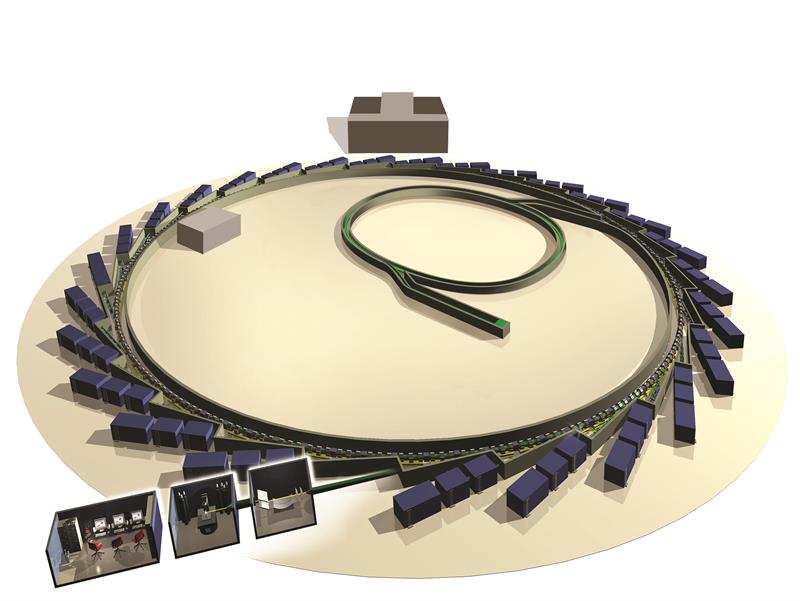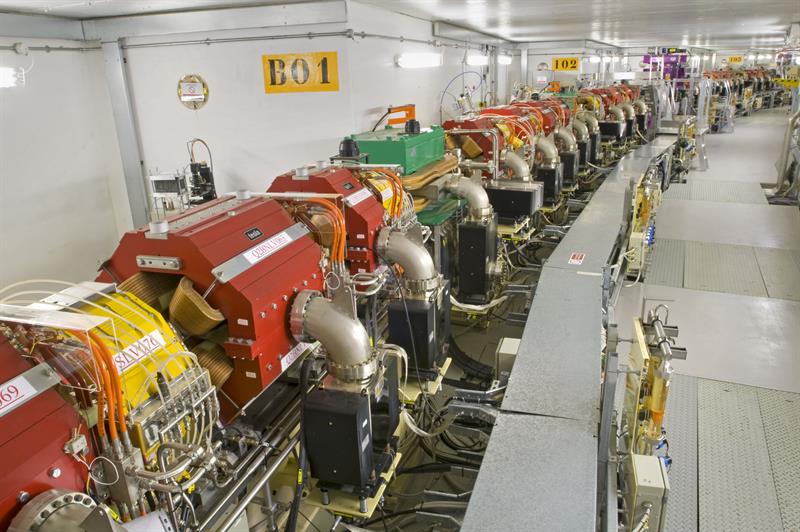Safety, performance, appearance... everything in automotive design is being squeezed, redeveloped and optimised. But such changes of course are no longer a mere flourish of the designers pen, or click of the mouse. And while complex simulations and wind tunnels provide invaluable information that can be used to iterate designs, such testing techniques will only go so far.
The next leaps in car design require the engineers to delve deeper, understanding the behaviour of the materials themselves and the way they change in manufacture and in service. To do this requires some ground-breaking test and measurement equipment - and some very bright lights. Welcome to the synchrotron.
Sited on the technology park at Harwell in Oxfordshire, the synchrotron is the UKs largest and latest and was designed, built and is operated by Diamond Light Source, a company owned by the Government (86%) and the Welcome Trust (14%). It is a place where science and engineering collide to provide designers with new building blocks for their products. There are many sectors that benefit from the facility including the physical and life sciences which feed medical and environmental developments. Another area, and the focus of the iCAR conference that the facility hosts, is automotive.
The science behind the synchrotron is incredibly complex, but the basic principle was outlined by Prof Andrew Harrison, CEO, Diamond Light Source, speaking at the last iCAR event. “Diamond Light Source produces brilliant light primarily in the form of x-rays,” he explained. “What we have is a storage ring in which circulates bunches of electrons close to the speed of light. As it goes round the ring the current of electrons gives out a brilliant flash of light in the x-ray part of the spectrum - we use that light to feed instruments that we think of as very high powered microscopes.” 
3D model of Diamond showing the individual beamlines. Image courtesy of Diamond Light Source
Diamond’s accelerator system starts out with a 100MeV (Mega electron volt) linear accelerator. The electrons are then accelerated up to 3Gev in a synchrotron with a circumference of 158m before they are injected at full energy into the main storage ring which has 24 sectors in a 561.6m circumference. Each sector is part of a double bend achromat lattice, each with two bending magnets, 10 quadrupole magnets and 7 sextupole magnets. This provides 24 straight sections of which 22 are for experimental stations.
“This allows you to look at the structure of materials at atomic scale,” continued Prof Harrison. “The work done on DNA 60 years ago would have used x-rays but x-rays in a laboratory are far, far less intense. Compared to the x-rays Crick and Watson used to determine the structure of DNA, Diamond is 10 billion times brighter.”
The consequence of that is that it possible to find the structure of much more complicated materials, which can be looked at more quickly and, most excitingly, can investigate structures as they are being transformed during processes. Prof Harrison said: “Traditional structures were seen as static – you see something in the beam and say that is the structure of that material. Increasingly what we are using x-rays to do is to look at how things change during a process – so it could be during a chemical reaction, it could be during an engineering process.”
One of the users is Prof Richard Dashwood, WMG Academic Director and CTO WMG centre HVM Catapult University of Warwick. He describes the work of the WMG as unusual in that it sees a key part of its role as sitting at the ‘elbow’ of industry. He commented: “In terms of research it is taking all the rigour and impact that you would expect from a university and applying that at scale but also across all the technology readiness levels – not just the fundamental research that you expect universities to do, but a lot of the applied research that needs to be done to gain the confidence of the industry to take it from research into action.”
A particular focus area for WMG is the automotive sector with its three main challenges of lightweighting, autonomous cars and advanced propulsion systems. Reaching EU CO2 targets for 2020 would involve cutting the weight of an average car by 170kg, he claimed, and to meet the 2030 target would require doing the same again. “So it’s all about making lighter, stronger materials that are greener, manufacturable in high volume and instead of thinking about a car as a steel can, we need to think about putting the right materials in the right part of the car,” he said. “All this requires some incredible research challenges going forward.”
So where does Diamond Light Source come in? Firstly they can provide some very detailed information about stress and what materials are present in the components. Prof Dashwood continued: “What is better than that is that we are getting to the point when we can do all of those things simultaneously and you can do that in real time. So we can work out what is happening to the materials while we are processing them, while we are shaping and joining them to make a car, and also what is happening in service.”
It is therefore also possible to work out what happens to a car in high strain rate events – e.g. during manufacture or in a crash – as that plays an important part in designing cars that are safe. He added: “It’s all about validating the models as well because you can’t design anything these days without having a mathematical model. And there are a lot of things we assume when we create these models that we can’t validate without these techniques.”
An example of the research concerns joining high strength steels. Over the past two decades the quest for lightweighting has resulted in steels becoming ten times stronger, but in doing so they have lost some of their ductility. They also have a problem when used with the traditional joining method - resistance spot welding. Using this process without any changes will result in a hard bit in the middle of the weld surrounded by a soft area - a doughnut area that will fail if any load is placed on it. Prof Dashwood commented: “What we were charged with doing, a project with Tata Steel, was to develop a model so that we could predict what the properties of a weld would be and then, by understanding the stresses that were developed inside that weld, what would happen if we applied a load. We used these facilities to validate that model.”
In another case, this time working with JLR, a problem needed resolving concerning cosmetic problems that were arising when the company was migrating from steel to aluminium. The phenomena of the ‘bruise’ (a black mark) appearing when metal was being formed round a tight radius was defying conventional modelling. “Again by looking at residual stresses inside,” said Prof Dashwood, “we realised that there was a lot of out of plane stresses, which are very rare in metal forming – most stresses are in plane, and all the modelling techniques that are used assume there are no out of plane stresses. So we had to go back and remodel that and came up with a solution. We wouldn’t have been able to achieve this without access to these facilities.”
Visiting Diamond Light Source does underline the impression that this is big science, but it is being used to solve genuine, real-life engineering problems. Prof Harrison concluded: “It is a two-way process and that is what we are trying to achieve here [with iCAR] - trying to get a greater understanding of what the industry needs."

A view along the storage ring. The electron beam travels through these tunnels, before being siphoned off into the beamlines for scientists to use in their experiments. The live electron beam means that access is restricted to when the machine is shut down. Image courtesy of Diamond Light Source











